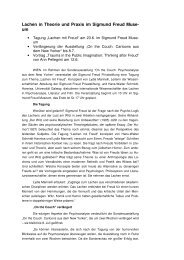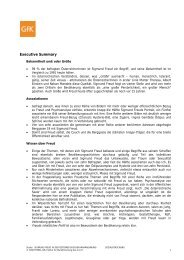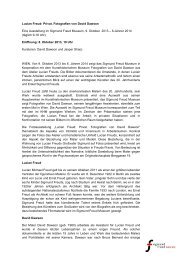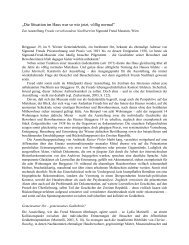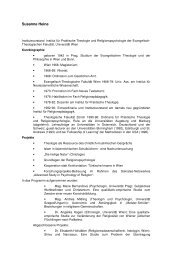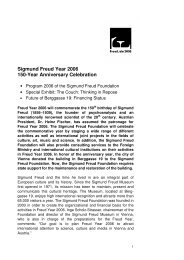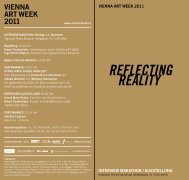Sigmund Freud-Museum | Newsletter - Sigmund Freud Museum Wien
Sigmund Freud-Museum | Newsletter - Sigmund Freud Museum Wien
Sigmund Freud-Museum | Newsletter - Sigmund Freud Museum Wien
Create successful ePaper yourself
Turn your PDF publications into a flip-book with our unique Google optimized e-Paper software.
ausstellung / exhibition<br />
Joseph Kosuth | ‚ Ansicht der Erinnerung‘ – ‘A View to Memory’<br />
In the former storefront of the Kornmehl Butcher Shop, the <strong>Sigmund</strong> <strong>Freud</strong> <strong>Museum</strong> together with the<br />
Society of Friends of the Fine Arts is presenting an installation by the American conceptual artist<br />
Joseph Kosuth starting on 1 May 2002.<br />
,Ansicht der Erinnerung‘ – ‘A View to Memory’ shows a fleeting moment in the history of the house<br />
at Berggasse 19. What is seen is a historical photo of the kosher butcher shop taken by Edmund<br />
Engelman in May 1938. A passerby stands with his back toward the camera looking into the display<br />
window filled with meat products. Above the photo is a quote from <strong>Sigmund</strong> <strong>Freud</strong>’s Psychopathology<br />
of Everyday Life.<br />
What is not overtly related by the photo is the historical and political context in which it was created.<br />
This is clarified by a small photo that is also mounted on the facade of Berggasse 19: A swastika flag<br />
hangs above the house’s entryway – as it did at the time on many other Viennese residential houses.<br />
German troops had marched into Austria two months previously.<br />
The detail view selected by the artist from the entire photo could also derive from a time other than<br />
that of National Socialism. It is not until one sees the historical full view including the house’s<br />
entryway that the installation’s meaning becomes transparent. This brings to mind the memories of the<br />
events of those days: Shortly thereafter, in June 1938, <strong>Sigmund</strong> <strong>Freud</strong> succeeded in emigrating with<br />
his family to London via Paris. Siegmund Kornmehl fled together with his wife Helene to Palestine<br />
in 1939.<br />
The documentary, neutral perspective that the photograph seems to carry is displaced by an awareness<br />
of its historical context. The observer in the photo’s foreground disappears, for instance, while the<br />
pieces of meat in the little shop’s display window take on an eerie life of their own. Or the passerby<br />
viewing the wares becomes an observer whose passivity is paradigmatic. Historical photographs give<br />
rise to problems in the present. In them the question is posed: What do we see when we look at an old<br />
image; what does it remind us of?<br />
Below we present the original text of the address given by the artist on April 30, 2002 on the occasion<br />
of the presentation of his installation at the <strong>Sigmund</strong> <strong>Freud</strong> <strong>Museum</strong>.<br />
Joseph Kosuth | The Text Between Memory and the Photograph<br />
I.<br />
“The part played by word-presentations now becomes perfectly clear. By their interposition internal<br />
thought-processes are made into perceptions. It is like a demonstration of the theorem that all<br />
knowledge has its origin in external perception. When a hypercathexis of the process of thinking takes<br />
place, thoughts are actually perceived – as if they came from without – and are consequently held to be<br />
true” (<strong>Sigmund</strong> <strong>Freud</strong>, The Ego and the Id, in The Standard Edition of the Complete Psychological<br />
Works of <strong>Sigmund</strong> <strong>Freud</strong>, vol. XIX, p. 23).<br />
We begin with an understanding that every photograph is also a text. It is information, as Roland<br />
Barthes once pointed out, and its structure is not an isolated structure. Attached to every image is a<br />
linguistic, textual component. With photography the past becomes anchored in the present. But here<br />
the ‘present’ survives only as a kind of theoretical object. It is really an interface between the past and<br />
desire. Language, that always present if internalized text, remains just that: a presence of the present.<br />
And the present is a flood of practical need compromised by desire. The photograph is a reduction<br />
caught in its own institutionalization, which, itself, is a screen for reality. A photograph exhausts<br />
reality, however, being a kind of self-contradiction which is itself central to its own ontological<br />
statement. Our very epistemology of seeing is very much now comprised of all of the photographs that<br />
depict our cultural reality. Few of these need to call themselves ‘art.’ Indeed art is increasingly located<br />
in the viewer, not in the viewed.



